COVER STORY
fees, for example, while the variable rate would tend to have a figure 4 in front of it. But, as always, you’ll need professional advice. Remember, the value of the family home or the home you live in and have equity in isn’t counted as an asset for age pension purposes, so it’s possible to live in a high-value property and be strapped for cash. “It might be a couple or an individual with a home that’s been in the family for generations – and they’d like it to stay that way but they need cash income to support themselves in their later years,” Ms Cooper says. But, she points out, nobody has a crystal ball: “You’re betting against future movements in the property market.” You need to be an age or disability pensioner, a Centrelink allowance recipient or at least qualify as such in order to be considered for the government scheme. At the same time, part of the Centrelink upside is flexibility. “You can usually transfer to another property,” says Ms Cooper. “Of course, you’d need to be assessed for that by Centrelink but there is at least the possibility to keep the program going.” In general terms, the younger you are, the less you can borrow and while the loan isn’t due until the home is sold, you can make repayments at any time (as you can with most private sector offerings). Centrelink will now consider loans over more than one property but unlike some private sector schemes, freehold is a must. “The major risk,” says Ms Cooper, “is that the equity could become negative in the event of a market crash. Also, any potential residential age care needs in the future need to be considered now.”
B
etween 1987 and 2015, the average mortgage debt for Australians over 55 grew from $27,000 to a terrifying
Brisbane
05.indd 3
EXAMPLE 1 Narelle Cooper cites her experience of an older couple who live in a $2 million home. Now in their 70s, they represent minimum risk in a reverse mortgage scenario. “But, again, I doubt if there’s such a thing as a no-risk scenario,” she says. “My advice, as it nearly always is, was to talk it over with the family.” Decisions we make today will have an impact on what our children and/or dependents can expect to inherit and could, potentially at least, expose them to a financial commitment if we ever need specialised care. In this case, the kids were onside so the couple can continue to enjoy the home and live a reasonable lifestyle. Everybody’s happy.
$185,000 (both measured in 2015 dollar values), according to a report from the Australian Housing and Urban Research Institute (AHURI). “Our research finds that back in 1987, only 14 per cent of older Australian homeowners were still paying off the mortgage on their home. That share doubled to 28 per cent in 2015,” report co-author Professor Rachel Ong ViforJ, of Curtin University told The New Daily recently. The research also found the average mortgage debt burden went from 13 per cent of the average home in the late 1980s, to about 30 per cent by the late 1990s. “Over that time, average annual mortgage repayments have more than tripled from $5000 to $17,000 in real terms,” she said. The meteoric growth is squeezing
retirement incomes and leaving more people with debilitating mortgage stress. Dr ViforJ said older mortgagors’ mental health was suffering from the added financial burden. Some mortgagors are even experiencing symptoms similar to those of long-term health problems. The key driver of mortgage debt growth is the housing boom and associated lifts in house prices, Dr ViforJ said. “House prices have steamed ahead at a much faster pace and grown much quicker than income levels, meaning people are finding it more difficult to get into home ownership until later in life,” she said. “It also means when people do get into home ownership, they have to take out a much larger mortgage debt in order to be able to buy that home.” “Outdated” policy settings put older Australians at risk. The increase in the number of people retiring with housing debt also has huge implications for housing assistance programs and, therefore, the government’s budget bottom line. “We’re predicting that between 2016 and 2031 that the number of older Australians needing Commonwealth rent assistance is going to spike from 414,000 to 664,000 – that’s a 60 per cent increase and is obviously going to put a lot of pressure on government as well.” Much of the government’s thinking was “outdated” when it came to managing housing affordability for older Australians, Dr ViforJ said. Specifically, government uses flawed assumptions about older Australians’ financial position to underpin its policies on social housing and the age pension. Those policies assume Australians have paid off most of their mortgage when they retire; that retirees will have
some form of nest egg, and will be able to get by on a modest pension. Dr ViforJ said these assumptions were getting rather outdated and government needed to review public housing supply and the age pension size to ensure the problem didn’t continue to swell. “We already have more older Australians that are carrying a mortgage debt and tipping out of home ownership. If you combine that with population ageing, that’s just going to blow out into a really large number,” she said. Making it easier for retirees to downsize their homes could also take some pressure off older Australians, allowing them to bring down their debt levels and free up more money. For many retirees, downsizing isn’t an option as the stamp duty costs and difficulty finding appropriate housing in suitable neighbourhoods makes it untenable.
EXAMPLE 2 Don and Andrea – in their late 60s – are in good health, own their home but need cash to give them a better lifestyle. After a working lifetime of monthly mortgage repayments, it seemed to them that the Australian dream of owning a home wasn’t all it’s cracked up to be if there’s not enough cash to adequately support themselves. After a family discussion (at the end of the day there may not be an awful lot left for the kids) they took the reverse mortgage plunge. And haven’t regretted it. They and the kids keep a careful watch on the market in general and review the position annually. So far, they are all comfortable.
February 2021 / YOUR TIME MAGAZINE 5
28/01/2021 10:25:16 AM













